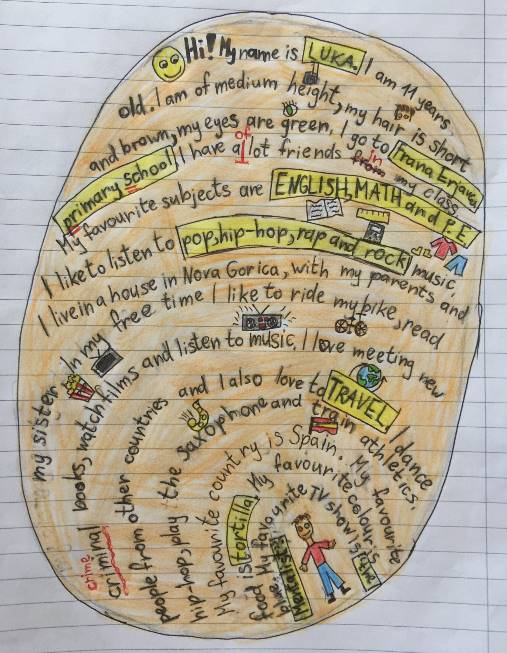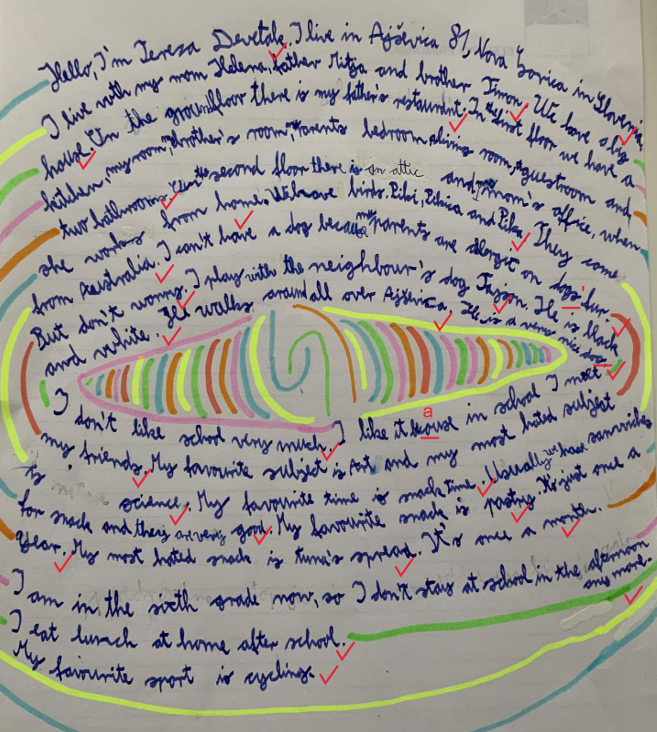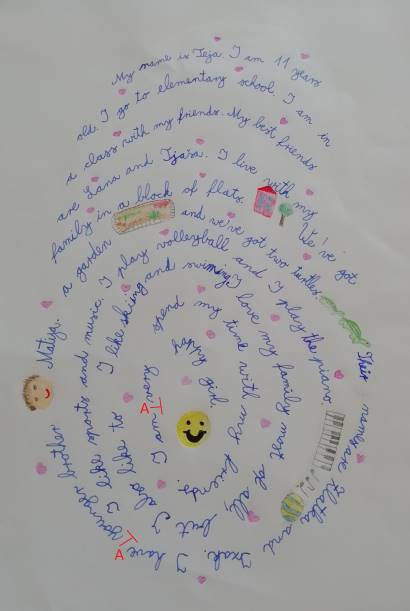Fingerprint Art - Creative Writing
Valentina Batagelj is a teacher at the Frana Erjavca Primary School in Nova Gorica, Slovenia. Following the practise of formative learning, she is dedicated to students being heard and being a part of the learning process. E-mail: valentina.batagelj@os-franaerjavca.si
Introduction
Within the learning progress of acquiring a foreign language, most teachers in primary schools tend to spend the majority of the time on explaining grammar, preparing and going through grammar exercises and testing grammar exercises, due to it being tangible and easy to grade, and serve as the basics which the students need for further learning. Turning the system upside down and seeing grammar as one of the means to reach a tangible goal is what the project “Fingerprint art”, carried out at the Fran Erjavec Primary School in Slovenia, did within a group of 6th grade students. Within the formative learning process, the students set their own goal of what they wanted to achieve at the middle of the school year; a fingerprint art with a creative description of who they are. The article presents writing which is a versatile and a time-consuming activity, and creativity and creative writing in a foreign language. It is focused on the process of carrying out the project of creative writing “Fingerprint art”, together with the students’ projects, which enabled them to develop their creativity and imagination and ultimately showed their uniqueness.
Writing in a foreign language
Writing a text in English is one of the indispensable competences one should have in a foreign language. In Slovenia, the 6th graders all over the country take a test named NPZ (Nacionalno preverjanje znanja) at the end of the school year. The last task within this exam is a written composition where three things are graded: the content, grammar and vocabulary. How to support the students for them to achieve all the points in each criterion is what every teacher in Slovenia contemplates. But what is writing in the first place?
Byrne (1988) states that writing is much more than the process of forming letters or combinations of letter, because letters have to be arranged according to certain rules in order to form words, and words have to be arranged in order to form sentences. There are numerous written compositions on what writing is but Ur made an interesting comparison between written and spoken language (1996) and came to an important conclusion that the written language usually has to be learnt, while the spoken one is normally acquired intuitively. Harmer (2007) also adds that the more we see and listen to comprehensible input, the more English we acquire, notice or learn and that this input can be a result of listening to audio material, reading various texts or interacting with other speakers. Harmer states that asking students to discuss a topic before starting the writing process, or offering them model texts is crucial. When it comes to free writing activities, which normally come after controlled and guided writing activities, Scott and Ytreberg (1990) state that simple forms of free writing activities should be used with lower levels as well. Moving a step further, into creative writing, Hyland (2002) describes it as any writing, fiction or non-fiction that occurs outside of everyday professional, journalistic, academic and technical forms of writing.
An example from the classroom
Keeping these experts’ guidelines in mind, together with one of the main goals of the formative learning that the students are the ones who create their learning goals, the first lesson before each new project is brainstorming what the goals of the following lessons will be. With the students, we talked about creativity and uniqueness as the starting point. The first step was looking at our fingerprints and discussing the lines each of us has and what they say about our uniqueness. Each of us has different and unique fingerprints and this is something that, for example, the police can use to identify who performed a certain crime, or to identify a body. Firstly, the students made their own fingerprint. Using an inkpad, they pressed in onto white paper. Secondly, they enlarged their fingerprint, by using a scanner. Thirdly, they drew over the lines. Using another piece of paper, they covered the fingerprint and carefully, following the lines, drew over their fingerprints. Before writing, they added some small pictures of things that mean a lot to them.
The next step was talking about the things they wish to mention in their description. This is the list of things they came up with: sports, friends, activities, family, appearance, favourite music, personality, pets, school, house/flat, free time. These were the topics that needed to be discussed in the first half of the school year, so that the students would be well acquainted with the vocabulary and the structures: the use of present simple, especially with the verbs “to be” and “to have”. These first conversations are of utmost importance. Based on them, the students do not just come to an English lesson four times a week and wait for what is the next topic to learn. They, the students, are the ones who set the topics themselves for the final result: the written compositions. The students know that each lesson is of utmost importance for them to reach their goal, so when we, for example, at a lesson talk about how to describe personality, do not take this topic as something else to listen to, but as something they need in order to write about themselves. Consequently, the students pay attention. The motivation is at an extremely high level and when the students get lost, do not understand something, they make sure they ask and find the information because every piece of information is of utmost importance. Each lesson following to the beginning of writing composition is like a jigsaw puzzle and the students are the active participants in the game in which puzzle is next to be used.
Lesson after lesson, we covered the topics that they chose: sports, friends, activities, family, appearance, favourite music, personality, pets, school, house/flat, free time. As a teacher, I provided what they needed on the specific topic. Each topic brought new questions, also how to use possession when talking about one’s family member or animal. Each written composition, new vocabulary or a video watched was brought due to their interest for learning more on what they needed.
Just like their fingerprints, their written compositions were unique and varied in length, content, complexity in grammar and the vocabulary they used. All the texts were written in school. They had the possibility to choose for the students’ peers or me to read their descriptions and correct the mistakes. They all chose one or the other and then improved their writings upon the corrections.

Picture 1: Fingerprint art with peer correction.

Picture 2: Fingerprint art with the teacher’s correction.

Most students choose to include art as well, although that was not obligatory. More creative compositions can be found on the school’s website: https://fransgottalent.wordpress.com/fingerprints/. All the text were displayed in the classroom. At the end of the project, the students read their classmates’ descriptions and not only read 26 more text but also learned more about the uniquness of their classmates and what they like to do, about their friends and famiy, free time, home, personality, favourite music, pets, school, sports.
Conclusion
The aim of the project “Fingerprint art” was to develop one of the skills in learning a foreign language; writing, and to be creative in this process. The students have, as them in the centre of creating the entire process, ultimately succeeded in doing so. The theoretical part provided important experts’ advice of what needs to be taken into consideration when embarking the journey of carrying out a written composition, and described how this was done in the 6th grade in the first half of the school year. The students were creative throughout this process and they could see what they had learned in a tangible way; written compositions on the walls of the classroom. As an end result, they did not only learn grammar and vocabulary, but also that they are all unique. The project offered room for their creativity and shall be used in the following years to come as model which will, beyond any doubt, be only upgraded by the generations to come.
References
Byrne, D. (1988) Teaching Writing Skills, Harlow: Longman
Harmer, J. (2007) The Practice of English Language Learning, Harlow: Pearson
Hyland, K. (2002) Teaching and Researching Writing, Harlow: Longman
Scott, A. W., Ytreberg, H. L. (1990) Teaching English to Children, Harlow: Longman
Ur, P. (1996) A Course in Language Teaching, Cambridge: Cambridge University Press
Please check the Pilgrims f2f courses at Pilgrims website.
Please check the Pilgrims online courses at Pilgrims website.
Christmas Fun: Nativity Scenes
Hanna Kryszewska, PolandThe Song on Speak Up: All I Want For Christmas Is You by Mariah Carey
Fingerprint Art - Creative Writing
Valentina Batagelj, SloveniaBringing Pub Quizzes into the Classroom
Anna Pereszlényi, HungaryFrom Sentences to Paragraphs: Tenses, Time Clauses, and Model Writing
Terence McLean, Canada5 Ways To Learn Different Accents Of English
Robert MacroHow a Teacher-coach Can Instil Intrinsic Motivation
Emmanuelle Betham, UK